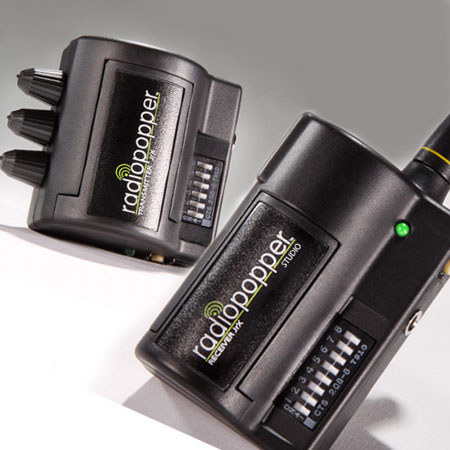


Review Summary
2020-06-16T02:02:15
I've used the Radiopopper JrXs for 12 years (2008-2020). The CR123 batteries are a little spendy although they work well. I never figured out why sometimes these things would not power off. I have spent way too many times pushing and holding the power button trying to turn each one off. I ended up just removing the batteries instead which also would prevent them from powering back on unwantingly. Now gaffers tape holds the battery doors on 3 of the 6 of my units. My biggest issue with these is the contact pin to the hot shoe on the transmitters. I've had 2 of them break. It was still possible to connect my cameras via cable and get good signal. But now 2 of my current cameras don't have a pc sync port on them and the pc sync hot shoe adapter isn't very reliable. So it was time to move on. But 12 years as my remote triggers for my slew of alienbee lights I'd say deserves at least 4 stars.
rossjamesphoto
2013-07-01T21:00:00
I own a Nikon D700, and multiple Alien Bees strobes, and was looking for a simple, inexpensive, and reliable radio triggers to minimize cords & cables on site during a shoot. The RadioPopper JRX Studio kit gives you everything you need to get started. Right out of the box, there is a glossy business card sized quick reference guide so that you can quickly set the dip switches on your transmitter and receiver to your desired RF channel, your desired RF group, and various other settings. If you want the manual, you'll have to visit their website and download it, but that's OK - you likely will not need more than 1 minute setting up with quick reference card, and you'll be up and shooting. I do photo and video work in the Washington DC area, and I've experienced a lot of RF interference with other radio-based digital devices (like wireless microphones, wireless video transmission), and I was unsure how these would perform in more difficult-for-RF-device areas like in the Pentagon. They have so far worked 100% in my usage, with no false triggers (phantom pops) and not a single failure to trigger. I think the best feature is the ability to simply turn a dial on the transmitter to adjust whole groups of flashes to a new output level. The trigger module can also work with Sekonic light meters in corded mode, so you can quickly take readings and make all of your adjustments on the fly from where your subject will sit, without having to raise/lower stands, or climb a step ladder again and again. The only thing I would change are a few tweaks to the casing. First, I would build them a bit more robust - the plastic (while lightweight, which I like) feels thin, and the knobs have a little bit of side-to-side wiggle in them. I believe they'll survive a long long time if treated well, but I'd pad them in your bag a bit more than you would pad a similarly priced CyberSync unit or higher priced PocketWizard unit. Second, I'd mark the output levels near the knobs on the transmitter, so you can figure out exactly how much flash you're using at a glance (currently, there are no markings. It's a 0-100% potentiometer with no hard stops for the corresponding levels on your strobe). My bottom line: I'd buy these again and again. At their price point, they cannot be beat, and they beat some of the competition. If you use Alien Bees strobes, the variable power control from the transmitter is extremely handy on-set, so you can maximize your shooting time and minimize your setup time.
Jason A.
2013-02-04T19:00:00
These work as promised. I do wish the knobs for controlling the flash output were a bit better defined. There is a lot of trial and error in finding the correct power.
BOB T.
2012-02-14T19:00:00
I was hesitant to buy these because of some negative reviews, but I had to try them because they sounded perfect for me. I use Nikon and Alien Bee Strobes and I'm not a TTL fan. So far I have used them on some portrait shoots at fairly close range and they do exactly as described. It's really nice to have control of 3 lights right on the camera, especailly if I am mixing the Alien Bees with some smaller strobes. I do not need the range of a sports photographer and hope they perform as well at weddings.
JOHN K.
Just a fantastic product!
By Jason A.
I own a Nikon D700, and multiple Alien Bees strobes, and was looking for a simple, inexpensive, and reliable radio triggers to minimize cords & cables on site during a shoot. The RadioPopper JRX Studio kit gives you everything you need to get started. Right out of the box, there is a glossy business card sized quick reference guide so that you can quickly set the dip switches on your transmitter and receiver to your desired RF channel, your desired RF group, and various other settings. If yo...
View full Review
The JrX Transmitter and Receivers provide tried and true basic triggering as well as the new EZset technology (requires JrX Receiver Studio). EZset enables on camera control of power levels of handheld TTL flashes, Alien Bees, White Lightning and Zeus brand strobes. NOTE that the EZset Strobe ability for use with TTL flashes requires the RPcube. For those looking to really unleash their lighting, try using the PX and JrX systems together.
Since all RadioPopper X products are fully compatible, a single PX transmitter unit can control all of your ETTL/iTTL strobes as well as any full power studio strobe with a sync port. Never before has a photographer been able to tailor off camera flash to meet their exact shooting style.